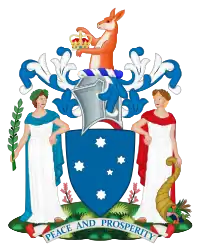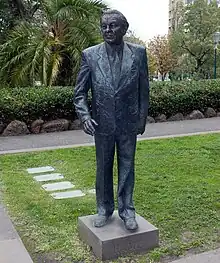Premier of Victoria
The premier of Victoria is the head of government of the Australian state of Victoria. The premier leads the Cabinet of Victoria and selects its ministers, who then become part of Victoria's executive council. To become premier, one must be a member of the Legislative Assembly, and command confidence in the house. This typically means being the leader of a political party who has the support of a majority of lower house members. The current premier is Jacinta Allan of the Australian Labor Party, who assumed the office on 27 September 2023 following the resignation of Daniel Andrews.
| Premier of Victoria | |
|---|---|
 | |
.svg.png.webp) | |
| Department of Premier and Cabinet | |
| Style |
|
| Status | Head of Government |
| Member of |
|
| Reports to | Parliament |
| Seat | 1 Treasury Place, Melbourne |
| Appointer | Governor of Victoria |
| Term length | At the Governor's pleasure by convention, based on appointee's ability to command confidence in the Legislative Assembly |
| Constituting instrument | None (constitutional convention) |
| Formation | 28 November 1855 |
| First holder | William Haines |
| Deputy | Deputy premier of Victoria |
| Salary | A$481,190 |
| Website | www.premier.vic.gov.au |
The Governor of Victoria, as the representative of the monarch, is responsible for appointing a new premier, typically when an existing premier resigns or loses an election.
The premier is considered the public face of the Victorian Government, leading cabinet, and representing the state during times of crisis or emergency.
History
Prior to federation
Victoria convened its first meeting of its Legislative Council on 11 November 1851 in Melbourne at St Patrick's Hall, Bourke Street West, with its primary focus being the establishment of a constitution that the Parliament of the United Kingdom could vote on to facilitate the separation of the Port Phillip District from New South Wales. The constitution passed British Parliament and received royal assent on 16 July 1855, allowing Victoria to become its own colony, named after the reigning monarch, Queen Victoria. Governor Charles Hotham appointed William Haines to be Victoria's first premier on 28 November 1855, with the first election, provided for by the Electoral Act 1856,[1] organised the following year.[2]
Victoria's first election elected Haines to serve his second term. This election was believed to be a world first, as it was the first time a secret ballot was used in an election. It also marked the beginning of Victoria's bicameral system, with its first sitting of parliament on 25 November 1856, taking place in Parliament House, Melbourne.[2]
In the early years of Victoria's political history, formal political parties did not exist, rather every member of parliament (MP) was essentially an independent making it difficult for any one member to command the confidence of the lower house. Consequentially, between the years 1855 and 1863 there were seven changes in government, and eleven instances when Governor Henry Barkly, was unable to find either an MP who would accept the role of premier, or an MP who was able to form a ministry amongst their parliamentary colleagues.[3]
Post federation
From Australia's federation in 1901 until the 1950s, Victorian political history was marked by instability, with 24 changes in government during that time. The 1955 election of Liberal Party leader Henry Bolte, who held office for 6,288 consecutive days, marked the end of the instability. Two more Liberal Party leaders, Rupert Hamer and Lindsay Thompson, immediately followed Bolte's premiership before the Labor Party won government in 1982 with John Cain, whose father had been the 34th Victorian premier, taking over as leader. Cain resigned from the office of premier in 1990[4] and was succeeded by Joan Kirner, Victoria's first female premier.[5]
Appointment and succession
To become a premier, one must both hold a seat in the lower house of Victorian Parliament and command the confidence of the majority of lower house members, meaning to have the support of a majority of lower house members. In practice, this is usually the leader of the political party or coalition with the majority of lower house seats.[6] In the event of a minority government, where the party of government does not hold a majority of seats in the lower house, the government is formed by the party, which, with members of the crossbench, is able to command the confidence of the lower house. This typically involves crossbench MPs making commitments of confidence and supply to the party they wish to form government.[7]
Following a premier's resignation or an election loss, the governor appoints a new government by swearing in the new premier and ministers.[8] If the government loses an election, conventions inherited from the Westminster system see the existing premier and ministers continue on a caretaker basis until a new government is appointed, thereby ensuring Victoria is never without a government.[8] Convention also requires an outgoing premier to advise the governor to call on the Leader of the Opposition to form a government and then to tender their own resignation and that of the defeated ministers. Ordinarily, the governor accepts the resignations and appoints a new government at the same time.[8] When a premier loses an election, the Leader of the Opposition (the Premier-elect) must assure the governor that they have the confidence of a majority in the Legislative Assembly. Upon being satisfied the governor commissions the Premier-elect to form a government and the new premier and the members of parliament nominated by them as ministers are then sworn in as Ministers of the Crown.[8]
There are no term limits imposed on a premier.[9]
Powers and role
The role of the premier includes leading the parliament, serving as the Chief Minister and Chair of Cabinet, selecting ministers and assigning portfolios, representing their electorate, handling portfolio responsibilities, and acting as the main channel of communication between the Victorian Government, the Governor and Cabinet, other state and territory governments, the Commonwealth Government, and overseas governments. The Premier is expected to have a vision for Victoria that addresses the major issues facing the state and includes plans for the state's continued prosperity.[10]
The Premier's executive powers are derived from acts passed through Parliament and the Constitution Act 1975 (Vic).[11]
Amenities of office

Salary
As of 1 July 2023, the premier is paid a total salary of A$481,190. This is made up of the 'basic salary' received by all Members of Parliament (A$198,839), an 'additional salary' for the role of premier (A$221,871), and an 'expense allowance' of A$60,480. Changes to the premier's salary are determined by the Victorian Independent Remuneration Tribunal.[12]
Portrait
Each premier since 1933, apart from Ian Macfarlan, who only served for 51 days, has had a portrait commissioned for the Victorian Parliament's portrait collection. The tradition was initiated by Legislative Council President Fred Grimwade.[13]
Statue
Premiers who hold the office for 3,000 days are granted a statue as a commemoration of their legacy. Five premiers, Daniel Andrews, Henry Bolte, John Cain Jr, Albert Dunstan, and Rupert Hamer, have achieved this milestone and four have their statues near the premier's office at 1 Treasury Place.[14] The four statues currently standing were sculpted in bronze by Peter Corlett and were installed in September 1999 after premier Jeff Kennett instituted the rule for premiers serving 3,000 days.[15] Daniel Andrews' statue is still pending completion. James McCulloch, despite serving for 3,230 days, does not have a statue; historians Paul Strangio and Brian J. Costar have posited that this is likely due to McCulloch serving his terms prior to federation and/or non-consecutively.[16]
Lists relating to the premiers of Victoria
The longest-serving premier was Henry Bolte, who served from 7 June 1955 to 23 August 1972 for a total of 17 years, and 77 days in office. He was a member of the Liberal Party. By contrast, the shortest-serving premier was George Elmslie, who served from 9 December 1913 to 22 December 1913 for a total of 13 days in office. He was also the first premier from the Labor Party.[17]
Lists of the people who have held the office:
Sources
![]() This article incorporates text from a free content work. Licensed under Creative Commons Attribution 4.0 (license statement/permission). Text taken from The Premier, Victorian Government.
This article incorporates text from a free content work. Licensed under Creative Commons Attribution 4.0 (license statement/permission). Text taken from The Premier, Victorian Government.
![]() This article incorporates text from a free content work. Licensed under Creative Commons Attribution 4.0 (license statement/permission). Text taken from Governor's role, Governor of Victoria.
This article incorporates text from a free content work. Licensed under Creative Commons Attribution 4.0 (license statement/permission). Text taken from Governor's role, Governor of Victoria.
References
- "Electoral Act 1856 (Vic)". Museum of Australian Democracy. Archived from the original on 6 April 2023. Retrieved 20 October 2023.
- Costar, Brian J; Strangio, Paul (2006). The Victorian Premiers, 1856-2006. Federation Press. p. 4. ISBN 1862876010. Archived from the original on 9 October 2023. Retrieved 5 October 2023.
- The Victorian Premiers, 1856-2006, p. 13.
- Forristal, Tom (16 April 1982). "Ministers of the Crown". Victoria Government Gazette. Victorian Government Printer. p. 1982:1025. Retrieved 4 October 2023.
- "Fact Sheet I1: Victoria's Parliamentary History". Parliament of Victoria. 25 February 2019. Archived from the original on 9 March 2022. Retrieved 9 October 2023.
- "The Premier". Victorian Government. 2 October 2023. Archived from the original on 12 May 2023. Retrieved 5 October 2023.
- Snowden, Angelica (25 November 2022). "How minority governments work". The Australian. Retrieved 5 October 2023.
- "Governor's role". Governor of Victoria. 22 September 2023. Archived from the original on 10 March 2018. Retrieved 5 October 2023.
- "Fact Sheet H1: Roles in the Assembly". Parliament of Victoria. 25 February 2019. Archived from the original on 3 December 2021. Retrieved 9 October 2023.
- "The Premier". Victorian Government. 2 October 2023. Archived from the original on 12 May 2023. Retrieved 6 October 2023.
- Allan, Jacinta (3 October 2023). "General Order dated 2 October 2023 - Premier". Victorian Government. Archived from the original on 9 October 2023. Retrieved 6 October 2023.
- McCann, Warren; Acton, Jennifer; Gardner, Laurinda (20 June 2023). Members of Parliament (Victoria) Determination No. 01/2023 (PDF). Victorian Independent Remuneration Tribunal. pp. 5, 8. ISBN 978-1-925789-93-5. Archived (PDF) from the original on 9 October 2023. Retrieved 6 October 2023.
- "History of the Premiers Portraits". Parliament of Victoria. 11 August 2022. Archived from the original on 10 May 2022. Retrieved 9 October 2023.
- Kolovos, Benita (18 February 2023). "A bronze North Face jacket? Daniel Andrews sized up for statue after 3,000 days as premier". Guardian Australia. Archived from the original on 26 September 2023. Retrieved 5 October 2023.
- The Victorian Premiers, 1856-2006, p. 1.
- The Victorian Premiers, 1856-2006, p. 2.
- Toy, Mitchell (21 April 2022). "How Victoria's first Labor premier lasted just 13 days". Herald Sun. Retrieved 6 October 2023.
Further reading
- Costar, Brian J; Strangio, Paul (2006). The Victorian Premiers, 1856-2006. Federation Press. ISBN 1862876010. Retrieved 5 October 2023.
